Spiders, often unnoticed in our daily lives, are a crucial part of the local ecosystem. In this article, we will discuss the intriguing world of the spiders that crawl around Houston. We’ll reveal the various species, their behaviors, and their significance in our environment.
By gaining insight into these creatures, we can develop a greater appreciation for their ecological roles and discover ways to peacefully coexist with them — despite their creepy looks. So, let’s dive in and get to know these 10 Houston spiders.
Venomous Spiders in Houston
Watch out for these spiders in Houston, as they all have one thing in common: they’re venomous!
1. Southern Black Widow (Latrodectus mactans)

Of course, one of the most dangerous spiders in Houston is the southern black widow.
©Jeff W. Jarrett/Shutterstock.com
In Houston, the southern black widow spider generally prefers outdoor habitats and occasionally ends up inside homes by accident. These spiders earned their name due to the fact that the females often consume their mate after mating.
Southern black widow spiders in Houston can be identified by a distinctive red hourglass-shaped marking on their lower abdomen. This bright red mark serves as a warning sign to deter potential threats. They are typically shiny black in color and measure between 0.3 to 0.5 inches in body length, including their legs.
Indoors, these spiders tend to seek out secluded spots. They are commonly encountered in outdoor structures like barns, garages, sheds, and outhouses.
Similar to most spiders, the southern black widow’s diet consists of various arthropods, including ants, caterpillars, beetles, and scorpions, among other insects.
While southern black widow spider bites seldom prove fatal to humans, seeking immediate medical attention if bitten is crucial, as their venom can lead to severe illness. These spiders are among the most venomous in Houston, with venom approximately 15 times more potent than that of rattlesnakes.
2. Brown Recluse (Loxosceles reclusa)
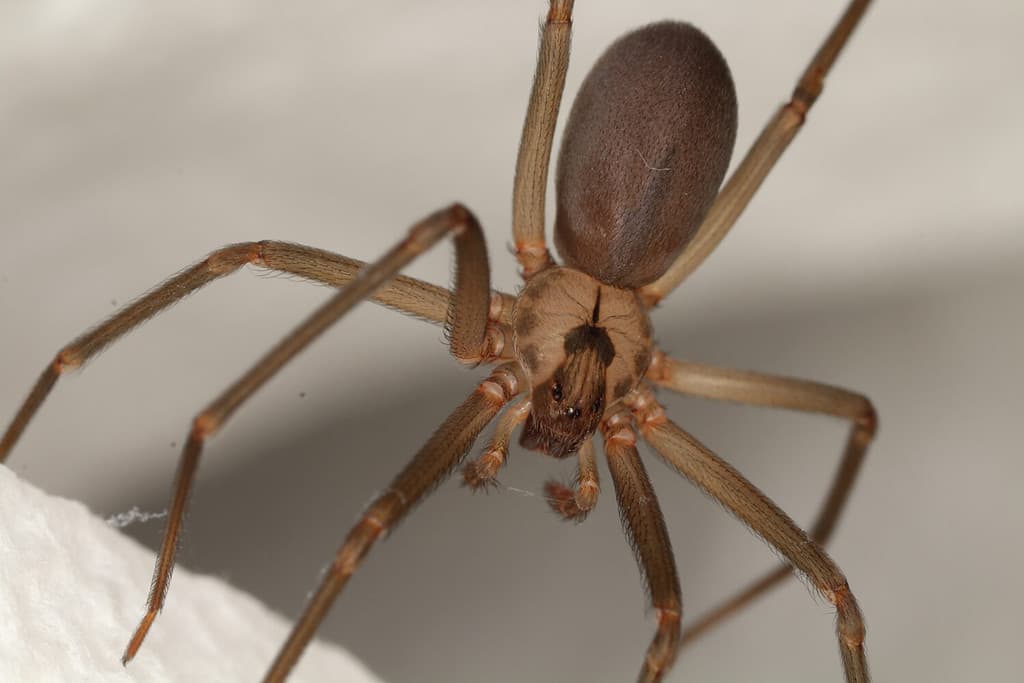
Another dangerous spider in Houston is the brown recluse.
©Nick626/Shutterstock.com
Brown recluse spiders, which are making their presence known in Houston, are feared due to their potent venom.
Grown brown recluse spiders typically measure between a quarter and a half an inch in size. They have a tan to dark brown hue and are often identified by a darker, violin-shaped mark on the upper part of their front body section. Interestingly, unlike other spiders, they have a total of six eyes, which are grouped in pairs, forming a semi-circular arrangement.
These spiders are known to be quite reserved, hence their name. They usually find hiding spots amidst clutter, secluded and dark corners in homes, within attics or garages, inside boxes, or amidst clothing left undisturbed for some time.
Brown recluse spiders generally sustain themselves on a diet consisting of insects with soft bodies, including cockroaches, moths, and flies. It’s also not uncommon for them to resort to cannibalism, feeding on each other.
While the venom of a brown recluse is indeed toxic, it usually doesn’t result in severe harm due to the small amount injected during a bite. The venom contains enzymes that can cause considerable damage to blood vessels and lead to cell death in the surrounding tissues of the bite site, also called necrosis
3. Brown Widow (Latrodectus geometricus)
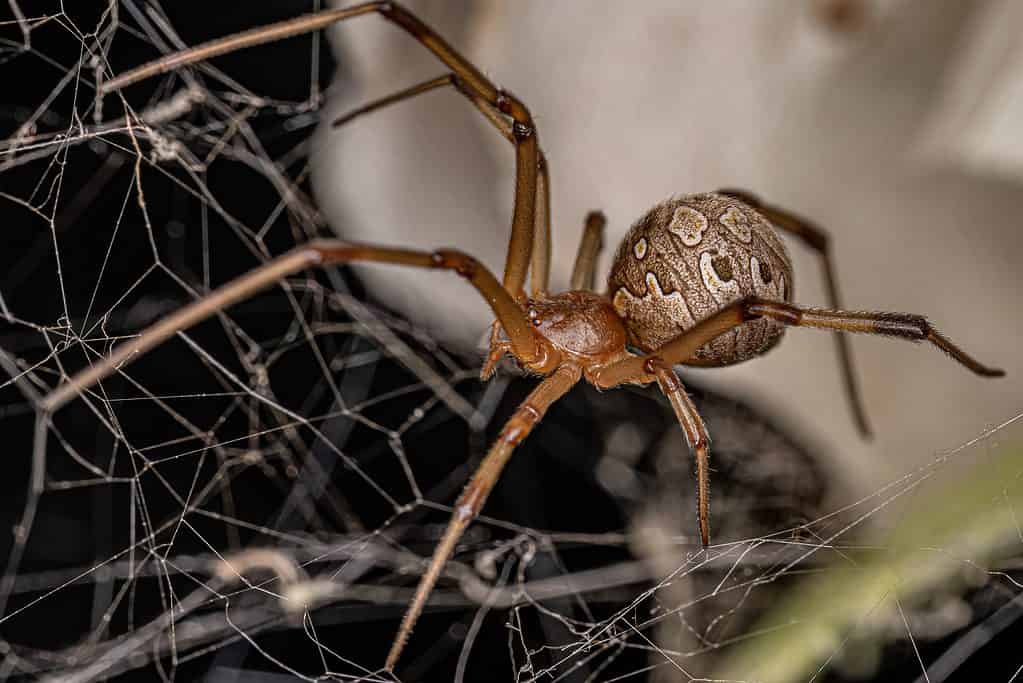
The brown widow spider is another venomous spider in Houston.
©Vinicius R. Souza/Shutterstock.com
Next up on our list is the brown widow spider, which has established itself in southern states, including South Carolina, Texas, Louisiana, and California.
Unlike its more famous black and red relative, the black widow, the brown widow sports a different look. Its coloration combines various shades of tan and brown, marked with black accents. In contrast to the striking red hourglass of the black widow, the mature female brown widow typically displays a red-orange hourglass on the underside.
Adult female brown widow spiders are medium to large, measuring around an inch long, including the legs, while males are roughly half the size of females.
These spiders prefer to construct their webs in concealed, sheltered locations around homes and in wooded areas with branches. Brown widows primarily feed on flies, mosquitoes, ants, roaches, and other insects.
If you happen to get bitten by a brown widow, you can expect symptoms similar to most spider bites, including pain at the bite site and a red mark. Despite having venom as potent as the black widow, the brown widow typically injects less venom, making it less dangerous. These spiders are rather reclusive and typically avoid human contact. Also, note that it’s only the adult female brown widow that bites.
4. Yellow Sac Spider (Cheiracanthium inclusum)

The yellow sac spider is venomous and can be difficult to spot.
©Rainer Fuhrmann/Shutterstock.com
In Houston, another spider to be cautious around is the yellow sac spider. These little spiders have bodies that measure about ¼ inch in length and can have legs stretching up to an inch. They primarily exhibit a yellow hue, as evidenced by their name, although they might sometimes appear light brown or yellowish-orange. Their elongated, pointed abdomens are paler compared to their cephalothoraxes (or heads). When young, these spiders can almost seem transparent, making them hard to spot.
You might encounter yellow sac spiders both in natural wooded environments as well as in homes and gardens. Although they are predators, they don’t venture far from their resting webs, usually set up under wood stacks, amidst yard waste, behind accumulated clutter, or along baseboards.
Their diet is quite diverse, including insects and other spider species (even those larger than them, such as hobo spiders), and at times, they might consume their partners or even their own offspring.
A bite from a yellow sac spider can cause an anaphylactic reaction. An uncommon but severe consequence of their bite might be tissue decay at the site of the bite, attributed to the cytotoxin present in their venom, which can induce necrosis in the affected area.
5. Texas Brown Tarantula (Aphonopelma hentzi)
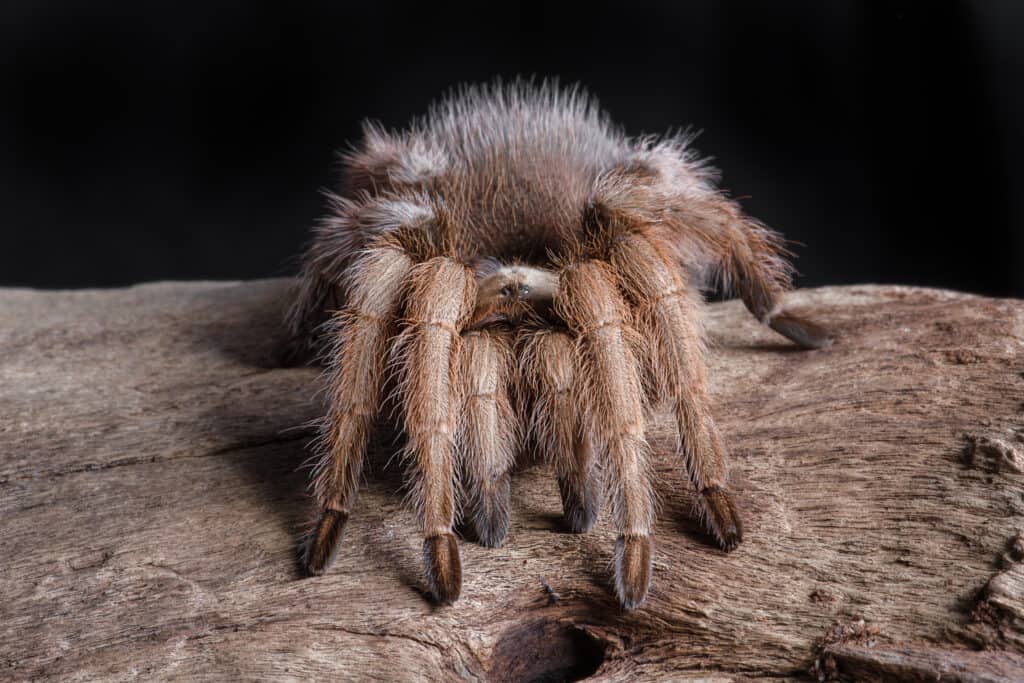
Texas brown tarantulas are one of the most dangerous spiders you’ll come across in Houston, but their bites are not fatal.
©Alan Tunnicliffe/Shutterstock.com
You can find tarantulas in various parts of Texas, including the bustling metro areas like Houston.
The Texas brown tarantula boasts a sturdy physique, featuring a substantial abdomen and front body section, both of which are brown, though their eight legs showcase a slightly darker shade. They are covered in prickly, brush-like fibers known as setae, and their impressive size, with a body ranging from 2 to 3 inches and a leg span of 5 inches, makes them larger than many smartphones.
Despite having eight eyes located at the front of their head, their sight is quite limited, relying more on the vibrations detected by their hairy setae to notice movement around them.
They prefer residing in areas with grassy terrains and partially open spaces. Their shelters range from natural hollows found under rocks or logs, gaps beneath the loose bark of trees, and abandoned burrows of rodents to the burrows they dig themselves.
Their dietary habits consist mainly of consuming small invertebrates. When kept in captivity, they are known to eat pet crickets, grasshoppers, and other live prey. However, they can also eat small lizards and mice!
While their demeanor is generally calm, they can make a defensive posture when threatened, where they stand on their back legs and lift their front ones. Even though they have venom, a bite from them is generally not fatal to humans. If you do get bit, it will feel much like a bee sting.
Non-Dangerous Spiders in Houston
You’ll often spot these spiders in Houston, but there’s no need to worry, as they aren’t venomous.
6. Tan Jumping Spider (Platycryptus undatus)
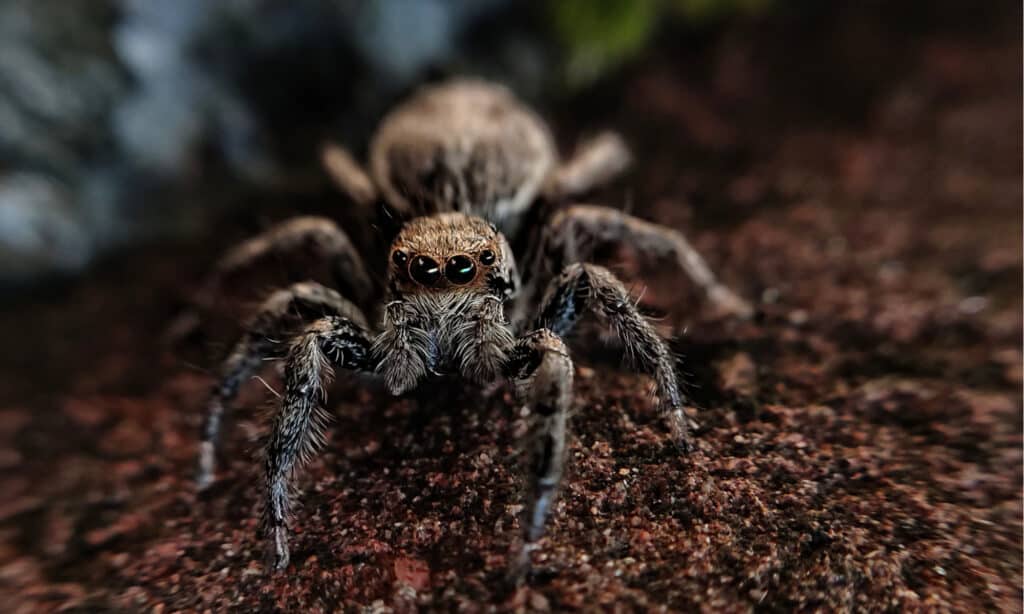
A non-venomous spider in Houston is the tan jumping spider.
©SwastikEs/Shutterstock.com
Tan jumping spiders are small, furry arachnids sporting prominent front-facing eyes. They also possess a set of eight eyes encircling their heads, providing them with nearly 360-degree vision. Their gray, tan, and brown colors help them blend seamlessly with tree bark, often featuring an undulating pattern on their abdomen.
Females of these spiders measure between 0.39 and 0.51 inches, while males are slightly smaller at 0.33 to 0.37 inches. You can commonly find tan jumping spiders on vertical surfaces like tree trunks, fence posts, and building walls. During the late fall months, they may venture indoors, exploring house walls.
Their diet comprises flies, aphids, moths, and even other spiders, thanks to their exceptional eyesight that aids them in hunting prey.
While tan jumping spiders may bite defensively in some situations, it’s important to note that their bites are not venomous. Consequently, these spiders pose minimal risk to humans, as they are more inclined to flee from people.
7. Common House Spider (Parasteatoda tepidariorum)
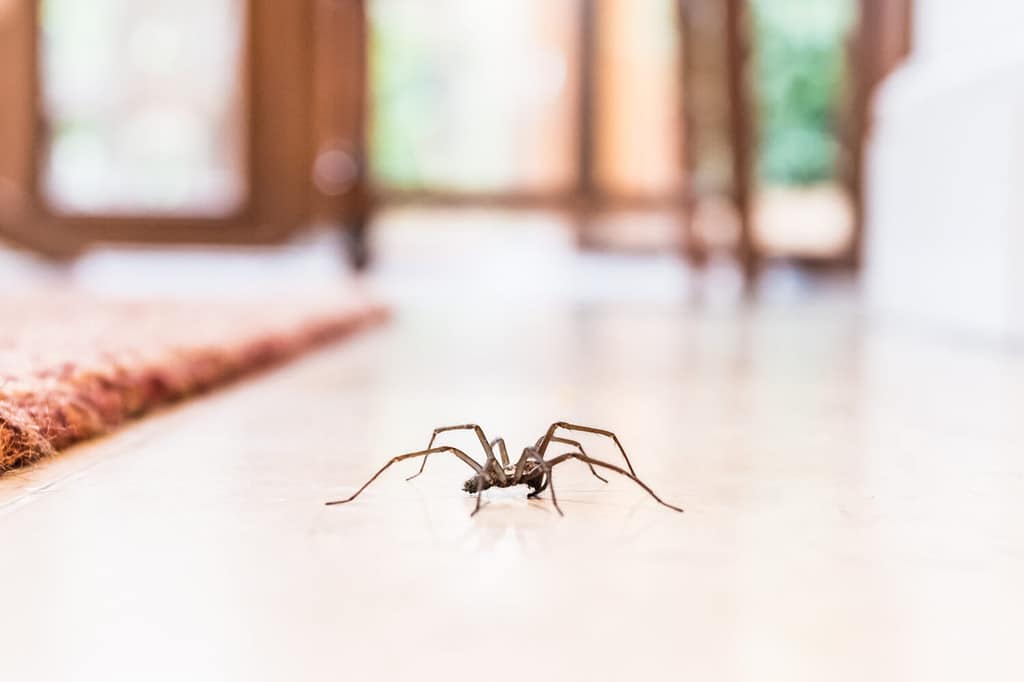
Surprisingly, the common house spider is venomous, but it’s not at all dangerous!
©Christine Bird/Shutterstock.com
The common house spider is frequently spotted in homes around Houston, making it a regular guest in many residences.
These spiders mainly feature a brown color, with some showcasing spots of brown or white on their abdomen. A distinct characteristic of the male spiders is their orange-tinged legs, whereas females have yellowish legs.
These spiders are generally small, measuring less than a quarter-inch, with females being slightly larger compared to males.
You can find these versatile creatures in various environments, from gardens and backyards to indoor spaces such as attics and basements. They are not picky eaters, and their diet primarily consists of insects, including flies and mosquitoes. However, they are also known to consume prey as large as grasshoppers and even other spiders on occasion.
Even though they do technically possess venom glands, there’s no cause for concern; their venom is not dangerous to humans.
8. Golden Silk Orbweaver (Trichonephila clavipes)
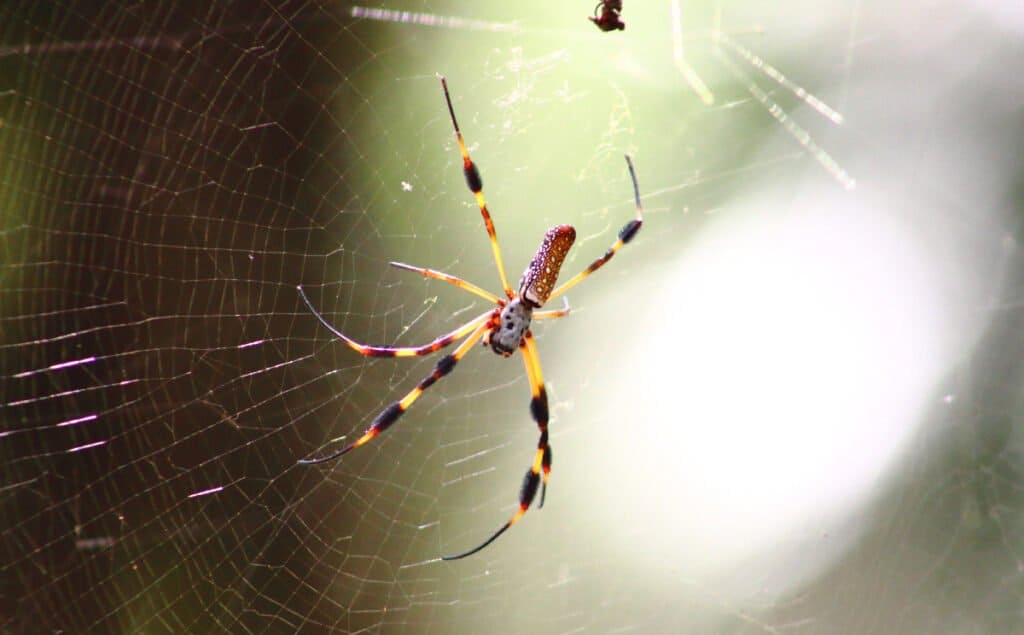
While the golden silk orbweaver can bite, the venom is non-toxic to humans.
©Max Rossa/Shutterstock.com
The golden silk orbweaver is a familiar sight to many in Houston.
Females notably hold the title as some of the most sizable web-spinning spiders in North America, potentially being the champions among the orbweaver category in the region. Females usually measure between 2 and 6 inches, while the more diminutive males range from 0.5 to 2 inches in length.
A closer look at the females reveals a captivating pattern that includes a silver-toned front body, yellow markings on an orangish-to-tan elongated torso, and legs adorned with bands of brown and orange or yellow. Their legs also feature distinctive hair brushes on the middle segment. In contrast, the males possess a more subdued dark brown appearance, making them less noticeable if it weren’t for their frequent presence in the females’ webs.
These spiders aren’t fussy eaters, consuming anything that their web ensnares. Their diet often comprises mosquitoes, bees, wasps, small moths, butterflies, flies, and even grasshoppers. You can spot them in various habitats, including dry open forests, coastal shrublands with sandy dunes, and mangroves.
Although the bite of a golden silk orbweaver can cause a bit of discomfort, it’s generally considered to be low-risk and non-toxic to humans.
9. Rabid Wolf Spider (Rabidosa rabida)
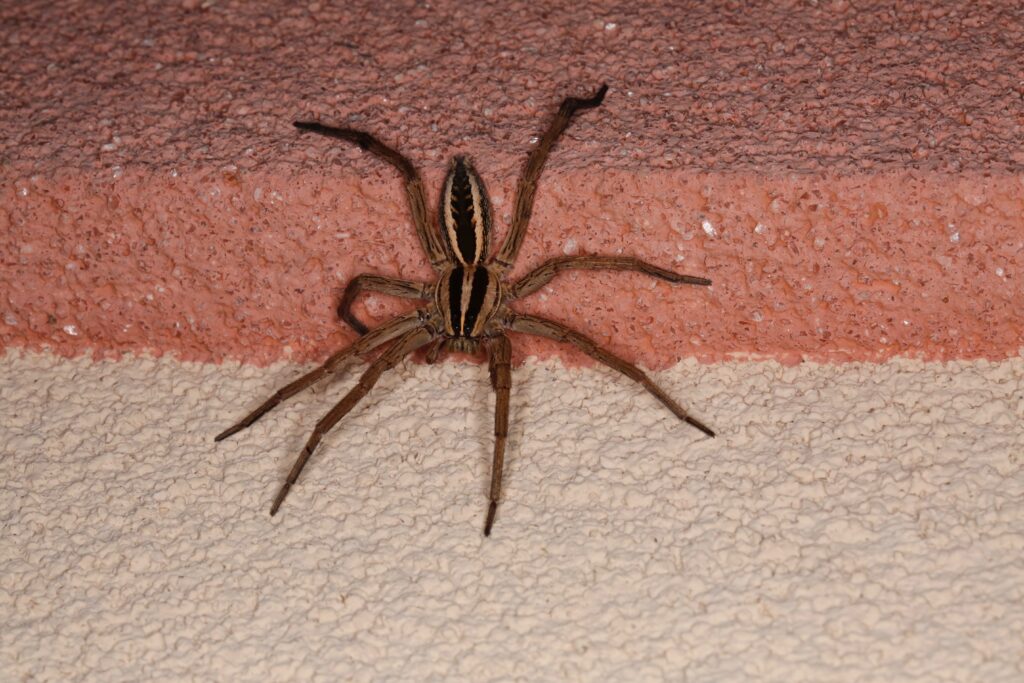
The rabid wolf spider is another spider in Houston that is not dangerous.
©Cathleen Wake Gorbatenko/Shutterstock.com
The rabid wolf spider, a common spider species in Houston and the Texas region, generally boasts a light brown color adorned with distinctive markings. This spider can be recognized by slender brown stripes running down its flanks, a pair of prominent dark lines gracing its head area, and a central dark brown stripe on its abdomen.
Female individuals of this species measure between 0.63 and 0.83 inches in body length, while the males are somewhat smaller. They can be found in cotton fields and forested regions, often taking up residence in crevices, amidst rubbish, or in sheltered burrows concealed by debris, sometimes even near water bodies.
When it comes to feeding, these spiders don’t hesitate to bite down on smaller prey instantly. In the case of larger prey, they use their legs to create a sort of enclosure before delivering the decisive bite. Their dietary preferences largely revolve around insects and smaller counterparts from the wolf spider family.
Despite the somewhat alarming name, rabid wolf spiders pose no threat to humans, as they are neither venomous nor actually rabid. The name “rabid” stems from their swift and somewhat erratic movements while hunting down prey.
10. Green Lynx Spider (Peucetia viridans)

Green lynx spiders are technically poisonous, but they don’t bite humans!
©Vengolis/CC BY-SA 4.0 – License
The green lynx spider is found widely in the eastern regions of the Carolinas, stretching south to Florida and westward all the way to California, including the whole of Texas.
This spider often sports a green color, as evidenced by its name. Its legs are dotted with numerous dark specks, giving it a distinctive appearance. While females of this species are relatively large, measuring between ½ to 5/8 inches, the males are notably more slender and slightly smaller, approximately half an inch in size.
You can frequently spot these spiders amidst bushy plants, where they remain motionless on blossoms, blending seamlessly into the surroundings as they lie in wait for prey.
Their diet mainly comprises beneficial insects such as butterflies, honeybees, and pollinating flies, among others, even managing to subdue prey larger than themselves. But these spiders also play a vital role in controlling the population of insects that may potentially damage crops.
Although green lynx spiders are not poisonous and seldom bite humans, one should be cautious as their bites can be quite painful. Moreover, the females have the ability to spray venom up to a distance of 8 inches when they perceive a threat.
Summary of the Spiders Crawling Around Houston
| Number | Spider | Venomous? |
|---|---|---|
| 1. | Southern Black Widow | Yes |
| 2. | Brown Recluse | Yes |
| 3. | Brown Widow | Yes |
| 4. | Yellow Sac Spider | Yes |
| 5. | Texas Brown Tarantula | Yes |
| 6. | Tan Jumping Spider | No |
| 7. | Common House Spider | Yes |
| 8. | Golden Silk Orbweaver | Yes |
| 9. | Rabid Wolf Spider | No |
| 10. | Green Lynx Spider | Yes |
The photo featured at the top of this post is © Alan Tunnicliffe/Shutterstock.com
Thank you for reading! Have some feedback for us? Contact the AZ Animals editorial team.






